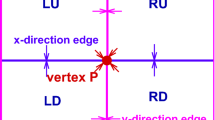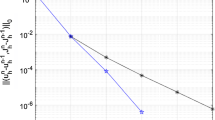Abstract
We consider a sub-model of the Hall-MHD equations: the so-called magnetic induction equations with Hall effect. These equations are non-linear and include third-order spatial and spatio-temporal mixed derivatives. We show that the energy of the solutions is bounded and design finite difference schemes that preserve the energy bounds for the continuous problem. We design both divergence preserving schemes and schemes with bounded divergence. We present a set of numerical experiments that demonstrate the robustness of the proposed schemes.





Similar content being viewed by others
References
Biskamp, D.: Nonlinear Magnetohydrodynamics. Cambridge University Press, New York (1993)
Carpenter, M.H., Nordström, J., Gottlieb, D.: A stable and conservative interface treatment of arbitrary spatial accuracy. J. Comput. Phys. 148, 341–365 (1999)
Fuchs, F.G., Karlsen, K., Mishra, S., Risebro, N.H.: Stable upwind schemes for the magnetic induction equation. Math. Model. Numer. Anal. 43(5), 825–852 (2009)
Fuchs, F.G., McMurry, A.D., Mishra, S., Risebro, N.H., Waagan, K.: Simulating waves in the upper solar atmosphere with SURYA: a well-balanced high-order finite volume code. Astrophys. J. 732(2), 75 (2011)
Gottlieb, S., Shu, C.-W., Tadmor, E.: Strong stability-preserving high-order time discretisation method. SIAM Rev. 43, 89–112 (2001)
Gurnett, D.A., Bhattacharjee, A.: Introduction to Plasma Physics. Cambridge University Press, New York (2005)
Hiptmair, R.: Multi-grid method for Maxwell’s equations. SIAM J. Numer. Anal. 36(1), 204–225 (1999)
Koley, U., Mishra, S., Risebro, N.H., Svärd, M.: Higher order finite difference schemes for the magnetic induction equations. BIT Numer. Math. 49(2), 375–395 (2009)
Koley, U., Mishra, S., Risebro, N.H., Svärd, M.: Higher order finite difference schemes for the magnetic induction equations with resistivity. IMA J. Numer. Anal. (2011). doi:10.1093/imanum/drg030
Kreiss, H.-O., Scherer, G.: Finite element and finite difference methods for hyperbolic partial differential equations. In: deBoor, C. (ed.) Mathematical Aspects of Finite Elements in Partial Differential Equations, pp. 195–212. Academic Press, New York (1974)
Ma, Z.W., Bhattacharjee, A.: Hall magnetohydrodynamic reconnection: the geospace environment challenge. J. Geophys. Res. 106, 3773–3782 (2001)
Mattsson, K., Nordström, J.: Summation by parts operators for finite difference approximations of second derivatives. J. Comput. Phys. 199, 2 (2004)
Mishra, S., Svärd, M.: On stability of numerical scheme via frozen coefficients and magnetic induction equations. BIT Numer. Math. 50(1), 85–108 (2010)
Mishra, S., Tadmor, E.: Constraint preserving schemes using potential-based fluxes. I. Multidimensional transport equations. Commun. Comput. Phys. 9(3), 688–710 (2010)
Qian, X., Balbás, J., Bhattacharjee, A., Yang, H.: A numerical study of magentic reconnection: A central scheme for Hall MHD. In: Tadmor, E., Liu, J.-G., Tzavaras, A. (eds.) Hyperbolic Problems: Theory, Numerics, Applications. Proceedings of the 12th International Conference held in University of Maryland, June 2008. AMS Proc. Symp. Applied Math., vol. 67, pp. 879–888 (2008)
Strand, B.: Summation by parts for finite difference approximations for d/dx. J. Comput. Phys. 110, 47–67 (1994)
Svärd, M., Nordström, J.: On the order of accuracy for difference approximations of initial-boundary value problems. J. Comput. Phys. 218, 333–352 (2006)
Torrilhon, M., Fey, M.: Constraint-preserving upwind methods for multidimensional advection equations. SIAM J. Numer. Anal. 42(4), 1694–1728 (2004)
Toth, G., Ma, Y.J., Gombosi, T.I.: Hall magnetohydrodynamics on block adaptive grids. J. Comput. Phys. 227, 6967–6984 (2008)
Author information
Authors and Affiliations
Corresponding author
Additional information
Communicated by Per Lötstedt.
Appendix: Finite difference operators
Appendix: Finite difference operators
The different operators used in our numerical experiment, are based on one dimensional operators coupled together with Kronecker product. The one dimensional operators are given for q=x,y,z in matrix form:
-
Second order central difference
$$D^{(2)}_{q}=P_q^{-1}Q= \frac{1}{2 \varDelta q} \begin{pmatrix} -2 & 2 & & & \\ -1 & 0 & 1 & &\\ &\ddots& \ddots& \ddots&\\ && -1 & 0 & 1 \\ &&& -2 & 2 \end{pmatrix} , \qquad P_q=\varDelta q \begin{pmatrix} \frac{1}{2} & & & &\\ & 1 & & & \\ &&\ddots&&\\ &&&1& \\ &&&&\frac{1}{2} \end{pmatrix} . $$ -
Fourth order central difference

Combining this operators we obtain the two spatial discretisation used in the numerical experiments.
We give the discrete derivative for the x direction, the ones for the other spatial directions are defined analogously.
Standard second and fourth order operator are
where I q are the identity matrices.
Rights and permissions
About this article
Cite this article
Corti, P., Mishra, S. Stable finite difference schemes for the magnetic induction equation with Hall effect. Bit Numer Math 52, 905–932 (2012). https://doi.org/10.1007/s10543-012-0383-3
Received:
Accepted:
Published:
Issue Date:
DOI: https://doi.org/10.1007/s10543-012-0383-3





